Abstract
Studies were undertaken to determine how a line of mutant Syrian hamster melanoma cells (HAB-2E) that displays unlimited growth potential when all of the thymine residues in nuclear DNA are replaced by bromouracil (BrUra) could avoid the deleterious effects of bromodeoxyuridine (BrdUrd) mutagenicity. It was found that BrdUrd could be mutagenic to these cells. However, there was a nonlinear relationship between mutagenicity and the amount of BrUra in the DNA of the HAB-2E cells. With these cells, mutagenicity apparently is determined by the concentration of BrdUrd to which the cells are exposed rather than the amount of BrUra in DNA. These results were obtained with both the induction of ouabain resistance and thioguanine resistance as markers for mutagenesis. The dependence of BrdUrd mutagenicity on BrdUrd concentration was also observed for the parental melanoma cells.
Full text
PDF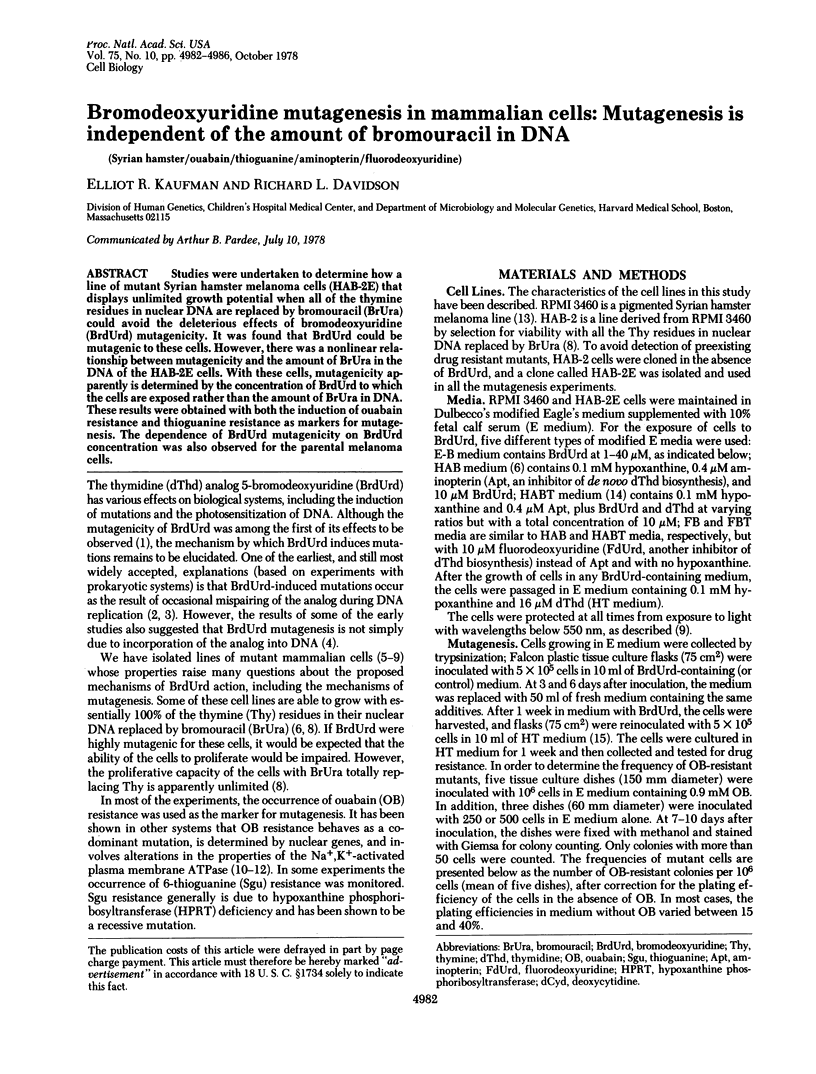
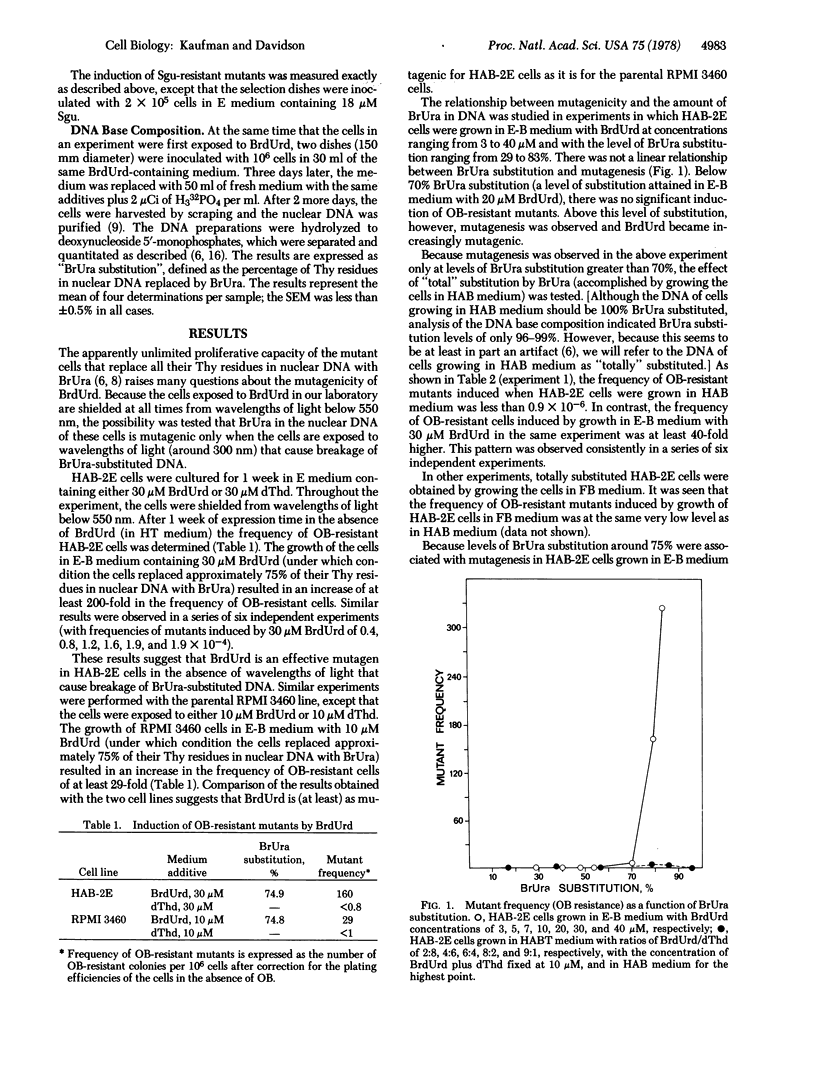
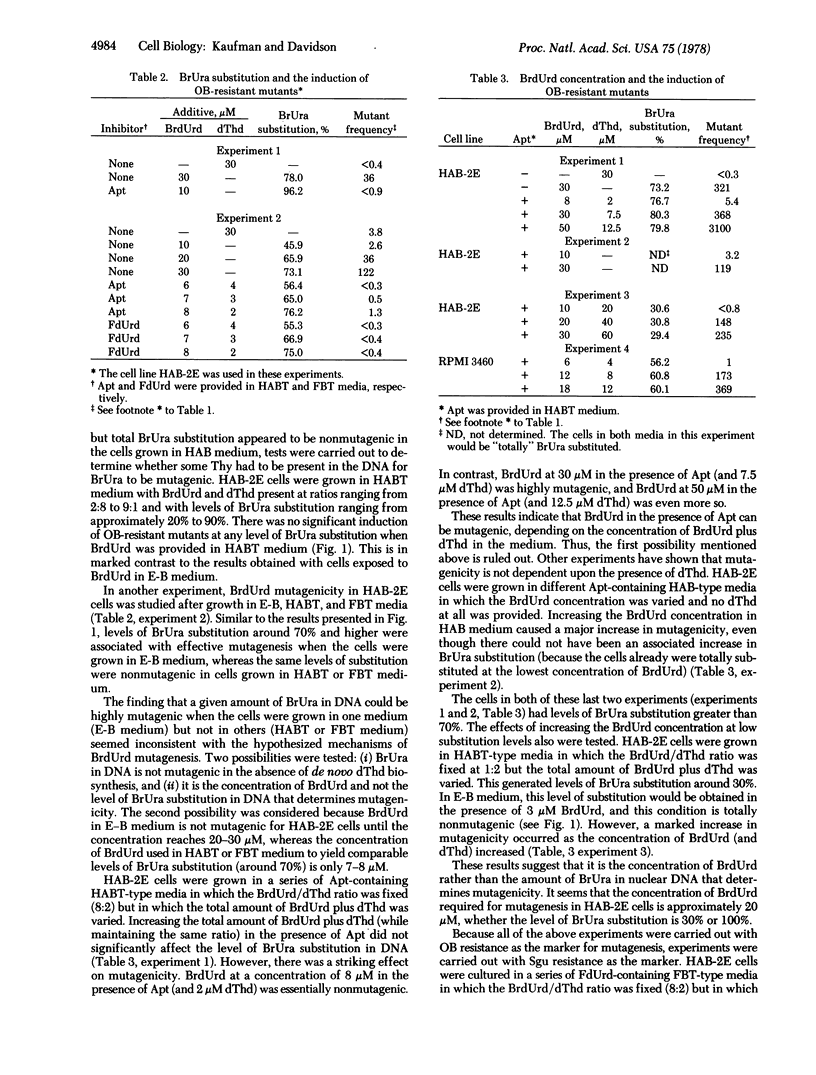
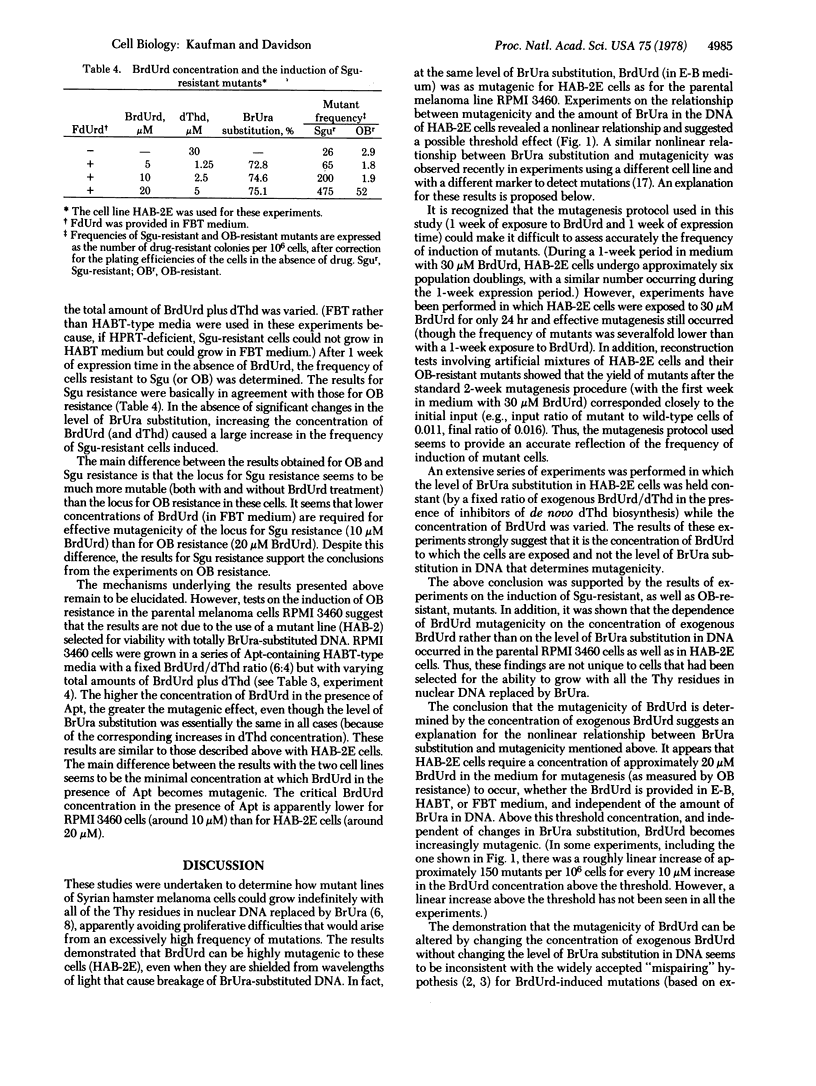
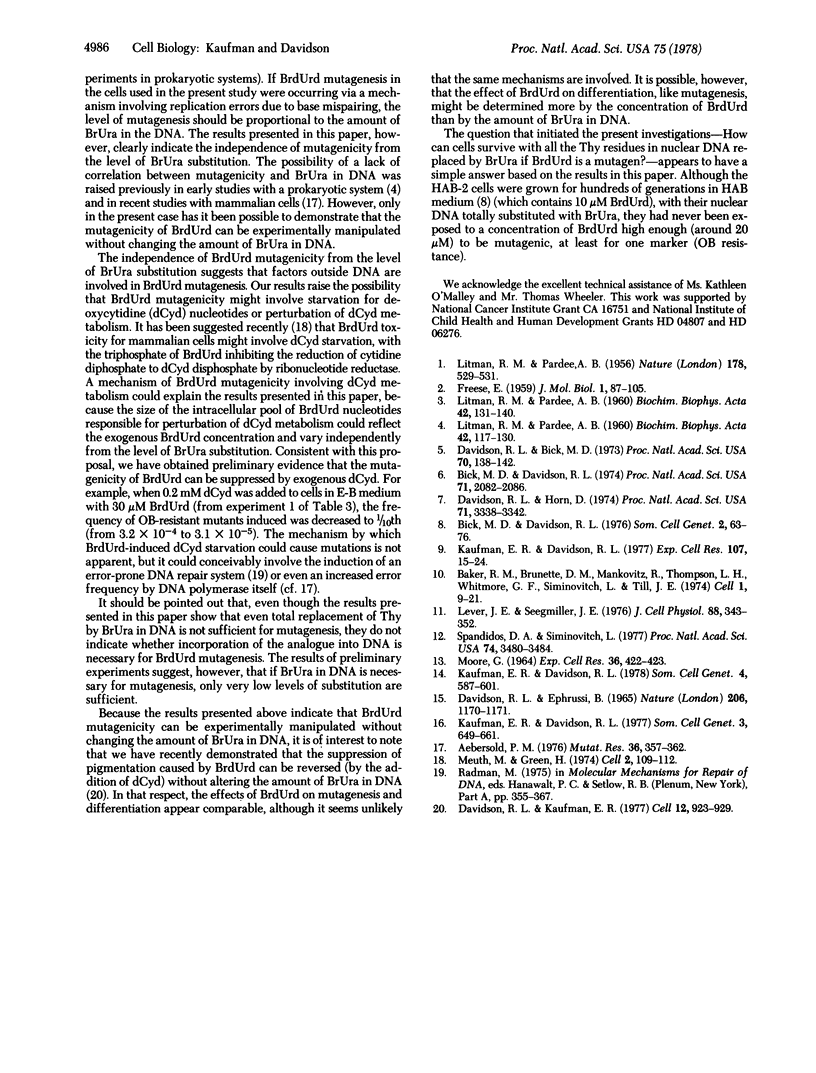
Selected References
These references are in PubMed. This may not be the complete list of references from this article.
- Aebersold P. M. Mutagenic mechanism of 5-bromodeoxyuridine in Chinese hamster cells. Mutat Res. 1976 Sep;36(3):357–362. doi: 10.1016/0027-5107(76)90245-1. [DOI] [PubMed] [Google Scholar]
- Bick M. D., Davidson R. L. Nucleotide analysis of DNA and RNA in cells with thymidine totally replaced by bromodeoxyuridine. Somatic Cell Genet. 1976 Jan;2(1):63–76. doi: 10.1007/BF01539243. [DOI] [PubMed] [Google Scholar]
- Bick M. D., Davidson R. L. Total substitution of bromodeoxyuridine for thymidine in the DNA of a bromodeoxyuridine-dependent cell line. Proc Natl Acad Sci U S A. 1974 May;71(5):2082–2086. doi: 10.1073/pnas.71.5.2082. [DOI] [PMC free article] [PubMed] [Google Scholar]
- Davidson R. L., Bick M. D. Bromodeoxyuridine dependence--a new mutation in mammalian cells. Proc Natl Acad Sci U S A. 1973 Jan;70(1):138–142. doi: 10.1073/pnas.70.1.138. [DOI] [PMC free article] [PubMed] [Google Scholar]
- Davidson R. L., Horn D. Reversible "transformation" of bromodeoxyuridine-dependent cells by bromodeoxyuridine. Proc Natl Acad Sci U S A. 1974 Sep;71(9):3338–3342. doi: 10.1073/pnas.71.9.3338. [DOI] [PMC free article] [PubMed] [Google Scholar]
- Davidson R. L., Kaufman E. R. Deoxycytidine reverses the suppression of pigmentation caused by 5-BrdUrd without changing the amount of 5-BrdUrd in DNA. Cell. 1977 Dec;12(4):923–929. doi: 10.1016/0092-8674(77)90156-8. [DOI] [PubMed] [Google Scholar]
- Kaufman E. R., Davidson R. L. Biological and biochemical effects of bromodeoxyuridine and deoxycytidine on Syrian hamster melanoma cells. Somatic Cell Genet. 1978 Sep;4(5):587–601. doi: 10.1007/BF01542928. [DOI] [PubMed] [Google Scholar]
- Kaufman E. R., Davidson R. L. Effects of thymidine analogs on Syrian hamster melanoma cells: phenotypes arising from selection for analog resistance. Somatic Cell Genet. 1977 Nov;3(6):649–661. doi: 10.1007/BF01539072. [DOI] [PubMed] [Google Scholar]
- Kaufman E. R., Davidson R. L. Novel phenotypes arising from selection of hamster melanoma cells for resistance to BUdR. Exp Cell Res. 1977 Jun;107(1):15–24. doi: 10.1016/0014-4827(77)90380-9. [DOI] [PubMed] [Google Scholar]
- LITMAN R. M., PARDEE A. B. Production of bacteriophage mutants by a disturbance of deoxyribonucleic acid metabolism. Nature. 1956 Sep 8;178(4532):529–531. doi: 10.1038/178529b0. [DOI] [PubMed] [Google Scholar]
- LITMAN R. M., PARDEE A. B. The induction of mutants of bacteriophage T2 by 5-bromouracil. III. Nutritional and structural evidence regarding mutagenic action. Biochim Biophys Acta. 1960 Jul 29;42:117–130. doi: 10.1016/0006-3002(60)90758-7. [DOI] [PubMed] [Google Scholar]
- LITMAN R. M., PARDEE A. B. The induction of mutants of bacteriophage T2 by 5-bromouracil. IV. Kinetics of bromouracil-induced mutagenesis. Biochim Biophys Acta. 1960 Jul 29;42:131–140. doi: 10.1016/0006-3002(60)90759-9. [DOI] [PubMed] [Google Scholar]
- Lever J. E., Seegmiller J. E. Ouabain-resistant human lymphoblastoid lines altered in the (Na+ + K+)-dependent ATPase membrane transport system. J Cell Physiol. 1976 Jul;88(3):343–352. doi: 10.1002/jcp.1040880310. [DOI] [PubMed] [Google Scholar]
- MOORE G. E. IN VITRO CULTURES OF A PIGMENTED HAMSTER MELANOMA CELL LINE. Exp Cell Res. 1964 Nov;36:422–423. doi: 10.1016/0014-4827(64)90224-1. [DOI] [PubMed] [Google Scholar]
- Meuth M., Green H. Induction of a deoxycytidineless state in cultured mammalian cells by bromodeoxyuridine. Cell. 1974 Jun;2(2):109–112. doi: 10.1016/0092-8674(74)90099-3. [DOI] [PubMed] [Google Scholar]
- Spandidos D. A., Siminovitch L. Transfer of codominant markers by isolated metaphase chromosomes in Chinese hamster ovary cells. Proc Natl Acad Sci U S A. 1977 Aug;74(8):3480–3484. doi: 10.1073/pnas.74.8.3480. [DOI] [PMC free article] [PubMed] [Google Scholar]


